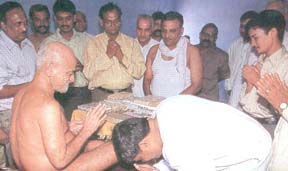Zealous Rally:- By Mr. Neeraj Mishra
|
Zealous Rally
By Mr. Neeraj Mishra Profound sermons, ornate temples, multi-purpose community projects - an aggressive movement to revive Jainism sweeps central India
Were it not for the several mikes blaring out an aarti sounding suspiciously like the latest Bollywood singles hit, it would be difficult to date the scene on stage to the right century. An unclothed seer squats on an elaborate lotus with a dozen similar figures on either side. As a thousand devotees wait, their faces moonlike in anticipation, the beatific central figure of Acharya Vidyasagar begins his pravachan with an inner calm more persuasive than the sermon. The message is 2,600 years old but it is witnessing a revival in central India, the fervors of which has not been seen since Lord Mahavir died in 527 B. C.
At the forefront of the resurgence is Vidyasagar, who is causing "a positive combustion" among the over 10 lakhs Jains in central India. Two years ago, he led more than five Lakh followers from all over the country in laying siege to the Kundalpur temples near Damoh in Bundelkhand. They wanted to build a new shrine adjacent to the protected 1,000- year-old temple. The Archaeological Survey of India had to back off an agree to the proposal. The moneyed Jains clearly are breaking free of their social low profile, self-imposed for years, and acquiring a new political, religious and social as sertiveness. Jain munis have inspired followers to take up temple, hospital and education projects estimated at well in excess of Rs. 500 crore. "This is the brightest period for the Jains in 500 years," says Professor R. C. Jain, a scholar who has carried out extensive studies on the religion and the community. "During the Mughal and British periods there was no state patronage and Jainism merely survived. Now it is spreading under the guidance of the New Age acharyas." The Internet and television have contributed towards this end, with Digambar and Shwetambar Acharyas delivering discourses from various channels. Among them, Vidyasagar has the biggest following with 59 munis, nine ailakh, five chul-lakhs and 112 Aryikas (women munis) under him. Three of his disciples- Viratsagar, Pushpadantsagar and Tarunsagar - have achieved acharyahood and now have their own sub-groups. Some 450 munis in Bundelkhand, among them doctors and engineers, have taken the vow of abstinence from worldly pleasures. There is new fervor for rites and rituals. "Fasting is now a sort of competition," says Vijay Jain, and industrialist from Raipur, Madhya Pradesh. More than 25,000 Jains attended the recent Paryushan Parva in Raipur which was heavily advertised in local newspapers. A big segment of the media is owned by Jains and some of them even have correspondents covering Jain activities. Prominent political leaders make it point to be seen being blessed by munis at such functions. The affluence of the Jains has lent them immense political clout. Take Vimal Bhandari whose Shwetambar Jain Samiti in Bhopal tool up the construction of a Jain temple at Manua Bhan Ki Tekri, the highest hill in Bhopal. The area was infested with criminal till Bhandari intervened and proposed the idea of a temple. Now the Rs. 5 crore project has been completed and includes a shrine, ropeway, dharamshala and a garden. Similarly, the Pushapagiri Teerth near Indore is a Rs. 100 crore project that envisages a school, a medical college, two temples and an artificial lake. "We are using community resources to run an English school for children from 36 villages," says Sanat Chabra who is involved with the project. At Amarkantak, Kundalpur, Pushpagiri and Nemavar too, elaborate temple projects are being under taken. They are part of the largest plan to revive Jain culture and architecture. The hands that created the Dilwara temples and Shravanabelgola may have finally found kindred souls in the 21st century.
----------------------------------------------------- Mail to : Ahimsa Foundation |
||

